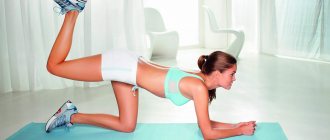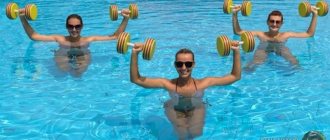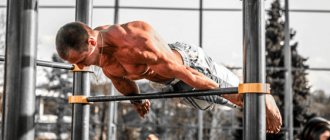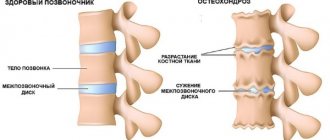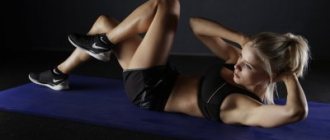Static exercises are a group of specialized exercises, the essence of which is to keep the body motionless. The point of this group of exercises is to apply extreme effort, which contributes to the expenditure of maximum strength, and therefore highly effective training. Today we will consider such a system as static, or as they are also called, isometric exercises.
What are static exercises
This is a group of physical activities and exercises, the main feature is tension without movement, that is, from a mechanical point of view, there is no work. During statistical exercises, the muscles are in a stationary position. A striking example is the traditional plank. While performing the plank, all muscle groups are involved: abs, back, arms, legs, buttocks, neck.
It is a common belief that static exercises require much more effort than dynamics and are unnatural. However, in fact, static loads are just as natural as dynamic ones, when you lift a barbell for biceps, curl on a block, perform cardio exercises, and so on. Another common misconception: statics have no benefits for the body. But if we consider the principle of muscle work during static and dynamic exercises, which we did below, it becomes obvious that statics are as useful and necessary as dynamics.
Correct execution of static training
You need to start the static exercise while inhaling. When performing it, the effort increases gradually and reaches a maximum, which lasts no more than 3 s. It is recommended to perform no more than 2-3 approaches.
Static training has its supporters and its critics. The most negative attitude towards isometric exercises is observed among athletes who strive to get maximum results in a short time. But if, in an effort to build muscle mass very quickly, you give an excessive static load, the consequences for the body will be unpleasant.
Therefore, the effectiveness of static exercises is ensured only by their reasonable use. They should be short-term, with a small number of approaches and in combination with other exercises.
The best static exercises
We will analyze the TOP 3 training elements for the body, as well as for each muscle group, so that you can create an individual workout.
Static exercises for the muscles of the whole body
1. Plank. This is an effective element that develops not only external, but also deep muscle fiber stabilizers. The beneficial combination of the simplest method of execution and the difficulty of maintaining the original position develops strength, patience, and endurance. Posture improves, core is trained.
So, place your palms parallel to your shoulder joints, place your feet shoulder-width apart, thus forming an even line. It is recommended to tense your abs so that there is no deflection in the lumbar region. At the very beginning, we stand for half a minute or a minute, then increase the time.
2. Reverse plank. This is a variation that also develops the body and has a positive strengthening effect. However, the greater bias here is on the shoulder girdle and back.
Place your hands under the shoulder joint, place your feet hip-width apart, or simply stretch them out. During execution, we make sure that the spine is straightened and the buttocks are in a tense state. Another important point is that you do not need to raise the pelvis too high, as this disrupts the normal position of the lumbar region.
3. Table. We place our palms under our shoulders, place our feet at the level of our hips or a little wider, and squeeze our legs at the knees, forming a right angle. The result is that your heels are under your kneecaps, your hands are under your shoulders, and your core is tense and pointing toward the ceiling. When holding the position, the main tension goes to the abdominal muscles, lumbar extensors and buttocks. It is important to control the tension in the buttocks and core, otherwise the desired result will not be achieved. The pelvis always tends upward, otherwise you can hang on your joints, which is not beneficial for the body.
You can complicate the exercise by performing it with support on only one leg. Based on your level of flexibility, keep your free leg at a right angle or straight. Do the workout on one leg first and then on the other.
Please note that during the exercise there is a large load on the hands. Therefore, it is necessary to first knead them by performing rotations first in one direction, then in the other. If you experience pain in your hands while doing the table, stop doing the exercise.
Static exercises for legs, buttocks and thighs
1. Squat. First, take a standing position, and then lower yourself into a squat, as if doing a classic squat. Ultimately, the thighs should be strictly parallel to the floor line. There is no need to squat too low, as this will increase the load on the knee joints. Your back should be kept straight, your arms can be crossed in front of you or extended forward, depending on how you feel comfortable maintaining your balance. As you perform, make sure that your core, buttocks, and hips are tense. You should start with half a minute, gradually increasing the time. If you are a beginner, you can hold on to a chair.
2. Sumo. This is a variation of the squat that focuses on the inner thigh muscles. You need to take a wide step, spread your legs to the sides. Now we do a squat so that the thighs become parallel to the floor line. In this case, your back should remain straight, your arms can be positioned in any way convenient for you: folded in front of you, placed on your waist or extended forward. You need to feel how the internal pelvic muscles, quadriceps, hamstrings, and buttocks tense. Please note that the greater the leg opening, the more effective the workout will be. If you are a beginner, you can first do shallow squats and help yourself using a chair as support.
3. Chair. First, you need to lean your back against a flat wall and slowly take a sitting position, imagining that you are sitting on a chair. A right angle should form at the knees, and a right angle should also form between the line of the thighs, which are parallel to the floor, and the back. Your arms can take any position that is convenient for you: they can be lowered along the body, placed on the waist or extended forward. As a beginner, you don't have to squat deeply and you can place your hands on your hips.
Static gymnastics for the back
1. Tilt of the body. First, stand facing the wall straight, with your feet shoulder-width apart. The distance between the body and the wall should be approximately 1.5 meters. Then we stretch our arms up and tilt our torso, straightening the spine. Ultimately, your arms should rest against the wall and your spine should form a line parallel to the floor. Make sure that your knees are strictly straight and your back is not rounded.
2. Swallow. This exercise not only strengthens the back muscles, but also develops a sense of balance. First, we take a standing position, then stretch our arms above our heads. We perform a gradual tilt, making sure that the line of the arms and torso is straight. Then we raise and extend one leg so that it continues the line of the arms and torso. Hold this position for at least 30 seconds and then return to the original position. Repeat the exercise, changing legs.
3. Balance on one leg. In this case, the main emphasis is on strengthening the hips. First, we stand up straight, and then raise one leg and bend it at the knee joint so that the thigh line is parallel to the floor line. At this time, your hands occupy any comfortable position. If you are just starting static training, you can support your leg with your hands.
For the press
1. Tilt. This exercise targets the oblique abdominal muscles. We stand up straight and place our feet shoulder-width apart. We raise one arm up and make a deep tilt in the opposite direction (that is, if we raised our right arm, we bend to the left and vice versa). We keep the pelvis straight, do not move it forward, backward or to the sides. We hold the incline for at least 30 seconds, more if possible, and return to the original position. We repeat the exercise, bending in the other direction.
2. Corner. We sit on the floor and straighten our back as much as possible. Then we carefully move our back back, forming an angle of 45 degrees. Please note that you need to sit on the pelvic bones without straining your tailbone. We tense our abdominal muscles. Now we lift our legs off the floor with the force of the press, straighten them and lift them. If it is difficult to keep your legs straight, bend them at the knees. Your arms must be straightened and held in front of you. Make sure your back is in a strictly straight position.
3. Angle with low amplitude. We lie on our backs and stretch our arms along the body, keeping our legs together. Now slowly lift your upper back off the floor and lift it, straining and bending your torso. After this, we raise our feet. During execution, it is necessary to control the tension of the core muscles.
Static exercises for weight loss
1. Shoulder bridge. During execution, the increased load is mainly placed on the muscles of the buttocks and thighs, as a result, calories are effectively burned. So, lie down on your back, bend your knees so that your feet are under them. Now slowly raise the pelvis, forming a straight line. Tightening the buttocks, we maintain a straight line of the body. We make sure that the chest does not protrude and the lower back does not arch. We stand in this position for 30 seconds.
2. Slide. This statistic comes from yoga (also known as downward-facing dog), and it not only has a strengthening effect, fights excess weight, but also increases the flexibility of the body. First, we take the position as for a plank, then we raise the pelvis up, parallel lower the thoracic spine to the floor, and straighten our arms. We aim our tailbone as high as possible. Now we press one leg to the chest, hold in this pose for 4-5 inhalations and exhalations.
3. Boat (hyperextension). We lie down directly on our stomach, and then raise our legs up, keeping them together. Now carefully raise the torso as much as possible. The arms remain straight along the body. You can place your palms under the pelvic bones so that they do not crash into the floor, causing discomfort and pain. The amplitude can be low, the main thing is to control the voltage.
→ How to perform static exercises if your back hurts
Static loads and their types
Thanks to the experiments of T. Hettinger and E. Müller, in 1953, static exercises (also called isometric) gained wide popularity among bodybuilders all over the world.
The essence of such exercises is muscle tension, in which the athlete’s body and limbs do not move in space, and the joints are fixed at a certain angle. To achieve this fixation, chains, ropes, various fixed supports, as well as weights weighing more than one time maximum of the athlete are used. An example of a static load would be lifting and holding a power apparatus (or your own body weight) motionless for a selected period of time, or until muscle failure occurs. It is important to realize that isometric training cannot be used constantly, they are only intended to add variety to training, since during static exercises the muscles receive too much load and they need more time to recover, otherwise overtraining may occur. In addition, in order to avoid muscle adaptation to constant, same-type loads, it is necessary to periodically change and supplement your training system.
Static loads are not always used in their pure form; they are often combined with dynamic ones. Thus, there are three main groups of isometric exercises:
- Truly static – when the load is provided by the irresistible force of resistance of the selected “simulators”;
- Dynamic exercises performed with weights, with the limbs fixed for a certain period of time (this way maximum muscle tension is achieved)
- Exercises performed using maximum weights (maximum weights).
As a result of combining the strengths of dynamic and isometric loads, there is also a system of combined “static-dynamic” exercises.
Static loads are most often used when performing bench or standing presses, biceps curls, various types of deadlifts, squats, and calf raises. The duration of static exercises also varies: short - usually from five to seven seconds, medium - from eight to eleven seconds, long - over twelve seconds. For athletes working with more moderate weights (75-85% of one-time maximum), static loads lasting 30-60 seconds are acceptable, provided that this time becomes the only approach followed by another exercise. This is a strength load, but if you hold the weight for more than a minute, the exercise becomes anaerobic, and the muscles no longer work on strength, but on endurance.
When performing static exercises correctly, the athlete exerts effort while inhaling, the tension in the muscles increases gradually, remaining maximum for no more than two to three seconds. The optimal number of approaches is two to three.
As before, static exercises currently cause a lot of controversy among their adherents and opponents. By the way, opponents of such loads are often people who strive to obtain maximum visible results in muscle mass gain in the shortest possible time. Usually their training leads to negative consequences and overstrain of the body as a whole due to improper execution and use of isometric exercises. So, if you decide to use static loads in your training system, remember that they are only short-term aids and must be alternated with dynamic loads.
So, let's take a closer look at the advantages and disadvantages of using isometric exercises.
How muscles work
Our muscles are made up of two types of fibers: fast and slow. Fast-twitch fibers take over the movement during cardio or strength training. Slow fibers are activated during prolonged tension in a particular pose. In order for the development of the body to proceed evenly and proportionally, the body to be healthy and resilient, and the relief to be formed more effectively, it is necessary to regularly engage in not only standard strength and cardio training, but also static training.
A set of exercises for developing strength
As practice shows, the development of physical strength is possible only when used in special complexes. Let's look at the most famous of them:
- a unique system of isometric and tendon exercises by Alexander Zass (“Iron Samson”), which is today the basis of isometrics for many of his followers;
- isometric exercises of Bruce Lee, holding a barbell on the biceps, squeezing a fixed bar up, holding a corner, often practiced in bodybuilding for beginners;
- Anokhin’s volitional gymnastics, designed to strengthen the body and increase physical strength.
Bruce Lee workout with isometric exercises
The legendary man - Bruce Lee also owes his extraordinary strength to isometrics. His complex is accessible even to a beginner athlete. For training, you will need a special equipment - a fixed barbell or crossbar at several levels. All exercises must be performed smoothly, with maximum effort.
- Push up the bar, fixed 10 cm below the height of outstretched arms, grasping it shoulder-width apart
- Press forward the bar fixed at chin level, grasping it widely
- Pull up the bar fixed at groin height, clasping it widely with your arms, straightening your back and throwing your head back
- Push out the crossbar, fixed 10 cm below the shoulder line, by sitting under it. When doing this exercise, keep your back straight and do not lift your heels.
Alexander Zass training
Alexander Ivanovich Zass is a famous strongman and circus artist who performed under the name Samson. He developed a special system of strength training based on Anokhin’s exercise complexes, the goal of which was to develop and strengthen tendons. Not having any particular height or other outstanding physical characteristics, Zass was awarded the title “The Strongest Man on Earth” and performed power routines until he was 66 years old. It is to him that the sports world owes the appearance of Iron Samson’s unique system of isometric exercises and a wrist dynamometer that allows one to measure the “Moment of Force”.
And today the Zass complex with a belt or chain is practiced by weightlifters, swimmers, rowers and skiers. When performing it, the athlete must monitor proper breathing and control the muscles. Samson's main complex includes strength tasks aimed at working different muscle groups.
- Try to stretch the chain by moving its ends apart at chest level.
- The same exercise, but the chain is placed behind the head and located at the level of the back of the head.
- The same exercise, but the chain is placed behind the back and its ends are pulled forward.
- Try to break the metal chain through your thigh while standing with your legs bent.
Watch the following video review of the exercises used in their training by Bruce Lee and Alexander Zass, with an explanation of the technique and breathing.
And a video review of the technique of performing isometric exercises by Alexander Zass.
Training Recommendations
To make your workouts effective, use the following tips:
1. Start performing each exercise for 30 seconds, and then gradually increase the duration.
2. Follow the execution technique, accuracy is more important than the period during which you lasted.
3. Combine static and dynamic for more effective weight loss.
4. The optimal duration of each exercise is 3 minutes. Before this, it is better to do dynamic training, activating the work of muscle mass.
Main complex
Statics in sports is a training complex aimed at developing the muscles of the cervical, thoracic, dorsal and gluteal regions, abdominal cavity, arms and legs. The most effective and popular types of isometric exercises, which are very easy to do at home, are given below.
Squat
When performing the exercise, only the mass of your own weight and long-term static load are involved.
Step-by-step description of the lesson:
- Feet should be placed shoulder width apart.
- Your arms should be placed in front of you at chest level.
- You need to bend your legs at the knees, locking in this position for about 30 seconds.
Afterwards you should straighten out and rest for 3 minutes. Next, you need to repeat the lesson again. It is advisable to do squats in 3 sets. They focus on developing the gluteal muscles and inner thighs.
Chair
You do not need to use a chair for this exercise.
The technique is as follows:
- You need to lean your back against any flat surface of the wall.
- Hands must be folded on the chest so that the palms reach the shoulder joints.
- Leaning on the wall, you need to bend your legs at the knees and sit down as deeply as possible, like on a chair. You need to stay in this position for at least 60 seconds.
Due to this, you can pump up the muscles of the buttocks and lower extremities. The exercise should be done in 3 sets with a break of 5 minutes.
Holding a raised leg
The exercise makes it possible to develop the lower abs and quadriceps of the legs.
It is as follows:
- Feet should be positioned shoulder-width apart, with your hands on your belt.
- When inhaling, the leg should be aligned at the knee and raised in front of you at the level of the groin area.
- The leg must be held for 40 seconds, maintaining balance.
The exercise must be performed for the right and left legs in turn. To achieve results, the training is carried out in 3 approaches with a break of 3 minutes.
Side lunge
The exercise is considered quite difficult, but effective. It makes it possible to develop the muscles of the inner and outer thigh.
To perform the workout correctly, it is recommended to adhere to the following steps:
- You will need to place your feet shoulder-width apart and place your hands on your belt.
- The right leg needs to be slowly bent until the limb is in a half-bent state.
- At this time, the left leg should be moved to the side, as if stretching.
You should remain in this position for about 30 seconds. Then you need to switch to the other leg. The training is carried out in 3 sets with a rest of 5 minutes.
Bridge
Complex training gives the same static load on the muscles of the anterior abdominal wall, middle segment of the back, lower back, as well as the buttocks and quadriceps of the legs.
To do the exercise, you must follow the following rules:
- You need to lie on your back on a hard and flat surface.
- Your legs should be bent and spread apart.
- You will need to place your hands along the body, fixing your palms on the floor surface.
- When inhaling, the buttocks should be raised, arching the back so that the scapular area comes into contact with the floor covering.
- The soles of your feet should be pressed to the floor.
You need to hold this position for 40 seconds. The workout consists of 3 repetitions with a 3-minute break.
Leg raises while lying on your stomach
Training allows you to strengthen and develop the muscles of the gluteal and dorsal region, as well as the biceps of the legs.
Step-by-step description of performing a static exercise:
- You need to lie on your stomach and put your hands under your head.
- Legs need to be bent at an angle of 90 degrees.
- At the moment of inhalation, you should bend your back, lifting your pelvic area from the floor covering.
The torso should be held for 30 seconds. Then you can rest for 3 minutes, and then repeat the workout twice.
Book
A lot of energy is spent on this exercise, but at the same time the muscle fibers of the anterior abdominal wall develop. The workout is suitable for those who are overweight.
The technique is as follows:
- You need to lie on your back with your feet shoulder-width apart and your arms out to the sides.
- At the moment of inhalation, you need to contract your abdominal muscles and immediately raise your arms and legs.
You must remain in this position for 25 seconds. In this case, the back must be straight. The workout consists of 2 approaches with a 3-minute rest.
Plank
It acts as a universal static workout that develops the muscles of the calves, buttocks, neck, back, arms, deltas, shoulder girdle and quadriceps. Bone and connective tissue along with joints are also strengthened.
The exercise should be carried out as follows:
- You should lie on your stomach with your legs together so that there is no space between them.
- The elbows account for the main isometric emphasis. Therefore, they need to be fixed to the floor covering.
- The feet will need to be leveled, touching the floor exclusively with the toes.
- The upper part of the legs and torso must be lifted off the floor covering, keeping the dorsal area flat.
The position must be maintained for 45 seconds. The workout consists of 3 sets with a 5-minute break. During the exercise, you should not arch your back and maintain even breathing.
Raise on toes
The exercise develops and strengthens the muscles of the buttocks, shoulder girdle and calves.
For proper training, it is recommended to follow these steps:
- Feet should be positioned shoulder width apart.
- Your arms need to be spread out to the sides and raised up. In this case, they should be at the level of the shoulder girdle.
- You should stand on your toes, touching the flooring with almost one toe.
- You need to stay in this position for about 30 seconds.
Then you can rest for 3 minutes. The workout consists of 2 sets.




